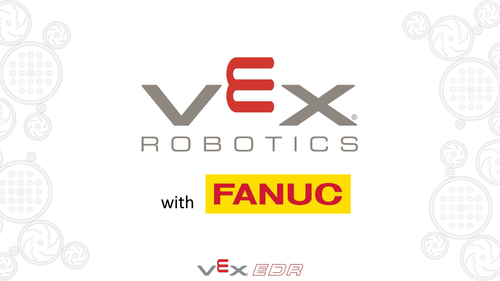
























This project encourages students to move beyond the VEX Robotics competition and typical classroom practice, and develop working knowledge of industrial, autonomous robotic solutions for the manufacturing sector. Students will ideally have completed the Tumbler Unit 1, Clawbot Unit 2, and Manufacturing Units 3.1 and 3.2 prior to commencing this project, though this is not essential. The ability to fabricate and manufacture custom parts to link with the VEX EDR equipment will lead to more complex and successful outcomes when combined.
1. * Lesson 01 - Introduction to the project and discussion about FANUC robotics, industrial robot applications and robotics in systems. Pupils learn about the elements of a typical robot, including key terminology and language used to describe industrial robotic solutions.
* Lesson 02 - Building skills are applied to replicate an existing design
* Lesson 03 – Pupils Learn how to operate a static VEX robot using the joystick and developed understanding of control, moving from playing to programming. They will then begin to map out a programme for the control of a static robot.
* Lesson 04 – Pupils will develop their working knowledge of programming language for robotic control and adapt a programme to achieve their goals.
* Lesson 05 – Pupils will learn about sensors and what sensors do and develop knowledge about how to integrate sensors into a robot to build a sensing robot.
* Lesson 06 - exploring the task of designing and sketching robot ideas, pupils will work in a team to develop a final solution and manufacture a final solution suited for testing against a design brief.
* Lesson 07 – Pupils work against the clock to explore the team dynamic and developed a final robot, Producing a final solution that achieves a purpose.
* Lesson 08 – Pupils will analyse a design brief and challenge and formulate design solutions that will meet the challenge. They will then start to develop initial ideas through sketches.
* Lesson 09 - Work initial ideas into an actual design solution and improve design solution by referring regularly to a technical specification. Thye will then go on to build the start of a final solution.
* Lesson 10 – Pupils will develop final build into a finished robot solution, programming robot to function and perform. They must ensure robots meet the specification in all technical aspects.
* Lesson 11 – pupils will plan and deliver a presentation of your robot and demonstrate robot as a proof of concept
* Lesson 12 - Students learn about methods FANUC use to establish a new project brief with a customer/client. Students’ pair up and work to a client and engineer role play task. They must take on the role of either, and through the use of Fanuc documentation, and apply analysis techniques to match client needs to design solutions
1. * Lesson 01 - Introduction to the project and discussion about FANUC robotics, industrial robot applications and robotics in systems. Pupils learn about the elements of a typical robot, including key terminology and language used to describe industrial robotic solutions.
* Lesson 02 - Building skills are applied to replicate an existing design
* Lesson 03 – Pupils Learn how to operate a static VEX robot using the joystick and developed understanding of control, moving from playing to programming. They will then begin to map out a programme for the control of a static robot.
* Lesson 04 – Pupils will develop their working knowledge of programming language for robotic control and adapt a programme to achieve their goals.
* Lesson 05 – Pupils will learn about sensors and what sensors do and develop knowledge about how to integrate sensors into a robot to build a sensing robot.
* Lesson 06 - exploring the task of designing and sketching robot ideas, pupils will work in a team to develop a final solution and manufacture a final solution suited for testing against a design brief.
* Lesson 07 – Pupils work against the clock to explore the team dynamic and developed a final robot, Producing a final solution that achieves a purpose.
* Lesson 08 – Pupils will analyse a design brief and challenge and formulate design solutions that will meet the challenge. They will then start to develop initial ideas through sketches.
* Lesson 09 - Work initial ideas into an actual design solution and improve design solution by referring regularly to a technical specification. Thye will then go on to build the start of a final solution.
* Lesson 10 – Pupils will develop final build into a finished robot solution, programming robot to function and perform. They must ensure robots meet the specification in all technical aspects.
* Lesson 11 – pupils will plan and deliver a presentation of your robot and demonstrate robot as a proof of concept
* Lesson 12 - Students learn about methods FANUC use to establish a new project brief with a customer/client. Students’ pair up and work to a client and engineer role play task. They must take on the role of either, and through the use of Fanuc documentation, and apply analysis techniques to match client needs to design solutions
Something went wrong, please try again later.
This resource hasn't been reviewed yet
To ensure quality for our reviews, only customers who have downloaded this resource can review it
Report this resourceto let us know if it violates our terms and conditions.
Our customer service team will review your report and will be in touch.
£0.00
